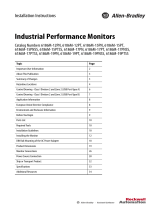
Publication 1784-IN003A-EN-P - October 2000
Installation Instructions
ControlNet PCI Communication
Interface Card
Catalog Number 1784-PCIC and 1784-PCICS
The 1784-PCIC and -PCICS cards are peripheral component interconnect (PCI)
open-bus interface cards. The cards enable PCI local bus compatible computers to
communicate directly with other ControlNet
TM
products.
The 1784-PCIC communication interface card is a messaging only card that provides
ControlNet monitoring and configuration capabilities. The 1784-PCICS
communication interface card provides ControlNet I/O bridging as well as
monitoring and configuration capabilities.
This document describes how to install the 1784-PCIC/PCICS ControlNet
communication interface cards.
Topic: Page:
Important User Information 2
About the Application Software 3
Rockwell Automation Support 4
European Communities (EC) Directive Compliance 5
Rockwell Automation Support 4
Install the Card Inside the Computer 6
Connect the Card 8
1784-PCIC and -PCICS Drivers 13
Interpret the Status Indicators on the 1784-PCIC and -PCICS 13
Specifications and Certifications 15
AB Parts

2 ControlNet PCI Communication Interface Card
Publication 1784-IN003A-EN-P - October 2000 Year
If you connect the card directly to a ControlNet COAX network, you may also need
to use:
• ControlNet Tap Installation Instructions, publication 1786-5.7
• ControlNet COAX Media Planning and Installation Manual, publication
CNET-IN002A-EN-P.
Important User Information
Because of the variety of uses for the products described in this publication, those
responsible for the application and use of this control equipment must satisfy
themselves that all necessary steps have been taken to assure that each application
and use meets all performance and safety requirements, including and applicable
laws, regulations codes and standards.
The illustrations, charts, sample programs and layout examples shown in this guide
are intended solely for purposes of example. Since there are many variables and
requirements associated with any particular installation, Allen-Bradley does not
assume responsibility or liability (to include intellectual property liability) for actual
use based upon the examples shown in this publication.
Allen-Bradley publication SGI-1.1, Safety Guidelines for the Application,
Installation, and Maintenance of Solid State Control (available from your local
Allen-Bradley office), describes some important differences between solid-state
equipment and electromechanical devices that should be taken into consideration
when applying products such as those described in this publication.
Reproduction of the contents of this copyrighted publication, in whole or in part,
without written permission of Rockwell Automation is prohibited.

ControlNet PCI Communication Interface Card 3
Publication 1784-IN003A-EN-P - October 2000
Throughout this document we use notes to make you aware of safety
considerations:
Attention statements help you to:
• identify a hazard
• avoid a hazard
• recognize the consequences
Identifies information that is critical for successful application and understanding
of the product.
About the Application Software
The Allen-Bradley standard application programming interface (API) is RSLinx
TM
software from Rockwell Software Inc. Contact your local Rockwell Automation sales
representative or distributor for further information.
ATTENTION
!
Identifies information about practices or circumstances
that can lead to personal injury or death, property damage
or economic loss.
AB Parts

4 ControlNet PCI Communication Interface Card
Publication 1784-IN003A-EN-P - October 2000 Year
Rockwell Automation Support
Rockwell Automation offers support services worldwide, with over 75 sales/support
offices, over 500 authorized distributors, and 260 authorized systems integrators
located throughout the United States alone, plus Rockwell Automation
representatives in every major country around the world. Contact your local
Rockwell Automation representative for:
• sales and order support
• product technical training
• warranty support
• support service agreements
Obtain Pre-Sales Product Support
If you need to contact Rockwell Automation for pre-sales product support, try one
of the following methods:
• Call your local Rockwell Automation representative
• Network Pre-Sales support line, 1.440.646.3638 (3NET)
• Pre-Sales e-mail, [email protected]ell.com
Obtain Technical Product Support
If you need to contact Rockwell Automation for technical assistance, try one of the
following methods:
• Call your local Rockwell Automation representative
• Post-Sales Technical Support, 1.440.646.5800
• Fax Back system, 1.440.646.5436 (requires a touch-tone telephone)
• Web Links http://www.ab.com — as a registered member, open to
http://www.ab.com/mem/technotes/techmain.html

ControlNet PCI Communication Interface Card 5
Publication 1784-IN003A-EN-P - October 2000
European Communities (EC) Directive Compliance
If this product has the CE mark it is approved for installation within the European
Union and EEA regions. It has been designed and tested to meet the following
directives.
EMC Directive
This product is tested to meet the Council Directive 89/336/EC Electromagnetic
Compatibility (EMC) by applying the following standards, in whole or in part,
documented in a technical construction file:
• EN 50081-2 EMC — Generic Emission Standard, Part 2 — Industrial
Environment
• EN 50082-2 EMC — Generic Immunity Standard, Part 2 — Industrial
Environment
This product is intended for use in an industrial environment.
Low Voltage Directive
This product is tested to meet Council Directive 73/23/EEC Low Voltage, by
applying the safety requirements of EN 61131-2 Programmable Controllers, Part 2 -
Equipment Requirements and Tests. For specific information required by EN
61131-2, see the appropriate sections in this publication, as well as the
Allen-Bradley publication Industrial Automation Wiring and Grounding Guidelines,
publication 1770-4.1.
This equipment is classified as open equipment and must be mounted in an
enclosure during operation to provide safety protection.
AB Parts

6 ControlNet PCI Communication Interface Card
Publication 1784-IN003A-EN-P - October 2000 Year
Handling the Card
Take these precautions to guard against ESD damage:
• Before you handle the card, touch a grounded object to discharge and
built-up static charge.
• Avoid touching the backplane connector or interface connector pins located
on the card.
• If the card is not in use, store it in the anti-static clamshell that the card was
shipped in.
Install the Card Inside the Computer
Before you install the card, be certain that you:
• know how to install hardware in your computer
• consult your computer’s documentation for hardware installation instructions
ATTENTION
!
The card uses CMOS technology, which is highly sensitive to
electrostatic discharge (ESD). ESD may be present whenever
you handle the card. When you handle the card without any
ESD protection you can cause internal circuit damage that may
not be apparent when you install or initially use the card.
TIP
Remember, a computer with ac power disconnected is not a
grounded object.
TIP
Installation instructions for both the 1784-PCIC and 1784-PCICS
cards are exactly the same. In most illustrations, the 1784-PCIC
card is shown.

ControlNet PCI Communication Interface Card 7
Publication 1784-IN003A-EN-P - October 2000
To install the card, you need to:
• access to the computer’s expansion slots
• possess either a Phillip-head or a flat-head screwdriver
• insert the card into the computer
Access the Computer’s PCI Local Bus Expansion Slots
To install the card, you must access the computer’s PCI local bus expansion slots.
Follow these general steps, or refer to your computer’s user guide for instructions
on how to:
1. Turn off the power to the host computer with the power switch.
2. Remove the computer’s cover.
3. Select a vacant PCI local bus expansion slot.
4. Loosen the screw on the back (rear bracket) of the computer.
5. Remove the slot’s expansion cover.
6. Insert the card.
To insert the card inside the computer:
1. Follow the card handling instructions on page 6.
2. Insert the card into the edge connector and tighten the expansion slot screw.
3. Turn on the computer to be certain that it comes up correctly.
4. When the computer boots up correctly, replace the computer’s cover.
If the computer: then:
powers up go to step 4
hangs up • you probably have a memory or I/O conflict
• you should remove all other cards and try again
If you continue to experience difficulty, contact your local
Rockwell Automation sales representative or distributor, or call
Rockwell Automation Technical Support at 440.646.5800.
AB Parts

8 ControlNet PCI Communication Interface Card
Publication 1784-IN003A-EN-P - October 2000 Year
Connect the Card
After you have installed the card, you can connect it:
• to a device already connected to the ControlNet network (page 9)
• directly to a ControlNet network, which requires a tap (page 12)
See Figure 1 on page 8 for the connectors and indicators.
Figure 1 1784-PCIC or -PCICS card (1784-PCIC card shown)
A
B
Network Access Port (NAP)
RJ-45 connector for connecting
programming terminals to devices on
a ControlNet network
Channel A
BNC connectors for connecting directly to
ControlNet network
Channel B
Do not connect more than one
ControlNet network to this card.
Redundant media
BNC connectors
Diagnostic status
indicators
42281
!
!
!
!
Allen-Bradley
1784-PCIC
ControlNet

ControlNet PCI Communication Interface Card 9
Publication 1784-IN003A-EN-P - October 2000
See page 13 for information about status indicators. Indicators diagnose only
redundant media BNC connections.
Connect to a Device on the ControlNet Network
The 1786-CP cable (Figure 2) connects a host computer to another ControlNet
device. It has two RJ-45 8-pin connectors.
Figure 2 1786-CP cable
ATTENTION
!
Do not connect more than one ControlNet network to this
card. If you attempt to connect a second network to this
card, your communication system will operate erratically.
If you connect or disconnect the ControlNet cable with
power applied to the module or any device on the network,
an electrical arc can occur. This could cause an explosion in
hazardous location installations. Be sure that power is
removed, or the area is non-hazardous before proceeding.
TIP
If you use a non-redundant cable system, all ControlNet
devices must be on the same channel, channel A.
RJ-45 8-pin connectors
1786-CP cable
30124-m
Connector 1
Connector 2
AB Parts

10 ControlNet PCI Communication Interface Card
Publication 1784-IN003A-EN-P - October 2000 Year
See Tables A and B for the wiring for the 1786-CP cable.
ATTENTION
!
Use only the 1786-CP cable when you connect a
programming terminal to the network through the network
access port (NAP). If you use a different cable, it could
result in possible network failures or product damage.
Table A Wiring for 1786-CP connector cable
Connector 1
Wire Number Signal Mnemonic Signal Name
1 ISO-GND Isolated Ground
2 N.C. No Connection
3 PTTX-H Transmit Data High
4 PTTX-L Transmit Data Low
5 PTRX-L Receive Data Low
6 PTRX-H Receive Data High
7 N.C. No Connection
8 ISO-GND Isolated Ground
Table B Wiring for 1786-CP connector cable
Connector 2
Wire Number Signal Mnemonic Signal Name
1 ISO-GND Isolated Ground
2 N.C. No Connection
3 PTRX-H Receive Data High
4 PTRX-L Receive Data Low
5 PTTX-L Transmit Data Low
6 PTTX-H Transmit Data High
7 N.C. No Connection
8 ISO-GND Isolated Ground

ControlNet PCI Communication Interface Card 11
Publication 1784-IN003A-EN-P - October 2000
When you use the RJ-45 connector, you can connect the card to a ControlNet
network without a tap through the Network Access Port (or NAP) of a
programmable controller, I/O adapter, or other ControlNet compliant devices
(Figure 3 and Figure 4).
Figure 3 Connect a computer to a ControlNet network through a programmable
controller or an I/O adapter
ATTENTION
!
If you connect the product to a cable system that does not
support redundant media, connect the tap dropline to the BNC
connector labeled channel A. Channel B is left open.
If the cable system is redundant, connect the product so that
all devices on the network use the same cable for the same
channel. That is, all channel A connectors connect to one
cable; all channel B connectors connect to the other.
1 The 1786-CP cable can be plugged into any ControlNet product’s NAP to provide programming
capability on the ControlNet network. When you connect a programming terminal through this
cable, it is counted as a node and must have a unique address.
ControlNet network
Programming
terminal
1784-PCIC or
-PCICS
1786-CP cable
1
ControlNet
product
42199
AB Parts

12 ControlNet PCI Communication Interface Card
Publication 1784-IN003A-EN-P - October 2000 Year
Figure 4 Connect a portable host computer to ControlNet through the 1784-PCIC
or -PCICS card
Connect the Card Directly to the ControlNet Network
To connect the card directly to a ControlNet network as shown in Figure 5, follow
the instructions in these publications:
• ControlNet Tap Installation Instructions, publication 1786-5.7
• ControlNet COAX Media Planning and Installation Manual, publication
CNET-IN002A-EN-P.
Figure 5 Connect the card directly to the ControlNet network
Portable host
computer
1784-PCIC or
-PCICS
1784-PCC
Desktop host
computer
1784-PCC1 cable
1
ControlNet network
42198
1
The 1784-PCC1 cable ships with the 1784-PCC communication card.
Desktop host
computer
1784-PCIC or
-PCICS
1786-TPR, -TPS, -TPYR, or -TPYS tap
ControlNet network
42200

ControlNet PCI Communication Interface Card 13
Publication 1784-IN003A-EN-P - October 2000
1784-PCIC and -PCICS Drivers
The drivers for the 1784-PCIC and -PCICS are included with either:
• Rockwell Software’s RSLinx 2.2 Service Pack 2
Or the combination of:
• Rockwell Software’s RSLinx 2.2 Service Pack 1 and
• Rockwell Automation’s SoftLogix 5800 6.00
Rockwell Software’s RSNetWorx for ControlNet 2.25 is required to configure a
ControlNet network containing the 1784-PCICS.
Refer to online Help in RSLinx for information on how to configure the driver for
the 1784-PCIC/PCICS card. For more information about RSLinx, visit
http://www.software.rockwell.com. See page 4 for additional technical support
information.
The 1784-PCIC and -PCICS cards require one of these operating systems:
• Windows NT 4.0, SP3
• Windows 98
• Windows 2000
Interpret the Status Indicators on the 1784-PCIC and -PCICS
The status indicators on the card give you information about the card and the
network when you’re connected via the BNC connectors. Table B outlines the
states and explains what each state means to you and the action you should take, if
any, to correct that state.
ControlNet status interpretation
• steady - indicator is on continuously in the defined state.
• alternating - the two indicators alternate between the two defined
states at the same time (applies to both indicators viewed together).
The two indicators are always in opposite states, out of phase.
• flashing - the indicator alternates between the two defined states
(applies to each indicator viewed independent of the other). If both
indicators flash, they must flash together, in phase.
IMPORTANT
When you connect the module to a ControlNet network using
the network access port (NAP) only, the LEDs are meaningless.
AB Parts

14 ControlNet PCI Communication Interface Card
Publication 1784-IN003A-EN-P - October 2000 Year
Table C ControlNet status interpretation
A and B
Cause: Action:
off • no power • none or apply power to the PC
• PCIC/PCICS driver not
started
• start RSLinx
• verify that the PCIC/PCICS driver has been
configured properly in RSLinx
• faulted card • check operating system event log for details of
fault (if the PC’s operating system supports an
event log)
• cycle power to the PC
• verify that you have firmly inserted the PCIC/
PCICS card into a PCI local bus expansion slot
and that the expansion slot screw is tightened
• if fault persists, contact your Rockwell
Automation representative or distributor
• see page 4 for technical support information
steady red • faulted card • check operating system event log for details of
fault (if the PC’s operating system supports an
event log)
• cycle power to the PC
• verify that you have firmly inserted the PCIC/
PCICS card into a PCI local bus expansion slot
and that the expansion slot screw is tightened
• if fault persists, contact your Rockwell
Automation representative or distributor
• see page 4 for technical support information
alternating red/green • self-test • none
alternating red/off • incorrect node
configuration
• duplicate ControlNet
node address
• check PCIC/PCICS node address and other
ControlNet configuration parameters
off • channel disabled • program network for redundant
media, if required
steady green • normal operation • none
flashing green/off • temporary network
errors
• check media for broken cables, loose
connectors, missing terminators, etc.
• if condition persists, refer to the ControlNet
Planning and Installation Manual, publication
1786-6.2.1
flashing red/off • media fault • check media for broken cables, loose
connectors, missing terminators, etc.
• if condition persists, refer to the ControlNet
Planning and Installation Manual, publication
1786-6.2.1

ControlNet PCI Communication Interface Card 15
Publication 1784-IN003A-EN-P - October 2000
Specifications
The operating parameters describe the environment within the card’s slot. Refer to
your computer documentation for environmental requirements. The card should
not exceed those specifications.
• no other nodes
present on network
• add other nodes to the network
flashing red/green • incorrect node
address
• change PCIC/PCICS node address so that it is
less than or equal to UMAX
1
• stop and restart the PCIC/PCICS driver in RSLinx
• incorrect network
configuration
• reconfigure the ControlNet network so that
UMAX
1
is greater than or equal to the PCIC/
PCICS node address
1
UMAX is the highest node address on a ControlNet network that can transmit data.
ATTENTION
!
This product must be mounted within a suitable system
enclosure to prevent personal injury resulting from
accessibility to live parts. The interior of this enclosure must
be accessible only by the use of a tool.
This industrial control equipment is intended to operate in a
Pollution Degree 2 environment, in overvoltage category II
applications, (as defined in IEC publication 664A) at altitudes
up to 2000 meters without derating.
Table D Specifications
General Specifications
Characteristic Value
Power Requirements 5 V dc, 700 mA Maximum, Class 2
Conductor Category 2
Use this conductor category information when you plan conductor
routing as described in publication 1770-4.1, Industrial Automation
Wiring and Grounding Guidelines.
Table C ControlNet status interpretation
A and B
Cause: Action:
AB Parts

16 ControlNet PCI Communication Interface Card
Publication 1784-IN003A-EN-P - October 2000 Year
Environmental Specifications
Operating Nonoperating
Slot Temperature
0 to 50
°C (32 to 122 F) -40 to 85° C (-40 to 185° F)
Humidity 5 to 95% without condensation 5 to 95% without condensation
Vibration 10 th 150 Hz, constant .012 in
displacement
10 to 150 Hz, constant 2.0G
acceleration
not applicable
Shock 30G peak/11 ms 50G peak/11 ms
Agency Certification
(when product or packaging is
marked)
UL Recognized Industrial Control Component
Certified Component Process Control Equipment
Certified Component Class I, Division 2,
Groups A, B, C, D
Marked for all applicable directives
Marked for all applicable acts
N223

ControlNet PCI Communication Interface Card 17
Publication 1784-IN003A-EN-P - October 2000
Hazardous Location Approval
The following information applies when operating this equipment in
hazardous locations:
Products marked “CL I, DIV 2, GP A, B, C, D” are suitable for use in Class I
Division 2 Groups A, B, C, D, Hazardous Locations and nonhazardous locations
only. Each product is supplied with markings on the rating nameplate indicating
the hazardous location temperature code. When combining products within a
system, the most adverse temperature code (lowest “T” number) may be used to
help determine the overall temperature code of the system. Combinations of
equipment in your system are subject to investigation by the local authority that
has jurisdiction at the time of installation.
EXPLOSION HAZARD –
• Do not disconnect equipment unless power has been removed or the area is
known to be nonhazardous.
• Do not disconnect connections to this equipment unless power has been removed
or the area is known to be nonhazardous. Secure any external connections that
mate to this equipment by using screws, sliding latches, threaded connectors, or
other means provided with this product.
• Substitution of components may impair suitability for Class I, Division 2.
• If this product contains batteries, they must only be changed in an area known to
be nonhazardous.
Informations sur l’utilisation de cet équipement
en environnements dangereux:
Les produits marqués « CL I, DIV 2, GP A, B, C, D » ne conviennent qu’à une
utilisation en environnements de Classe I Division 2 Groupes A, B, C, D
dangereux et non dangereux. Chaque produit est livré avec des marquages sur sa
plaque d’identification qui indiquent le code de température pour les
environnements dangereux. Lorsque plusieurs produits sont combinés dans un
système, le code de température le plus défavorable (code de température le plus
faible) peut être utilisé pour déterminer le code de température global du
système. Les combinaisons d’équipements dans le système sont sujettes à
inspection par les autorités locales qualifiées au moment de l’installation.
RISQUE D’EXPLOSION –
• Couper le courant ou s’assurer que l’environnement est classé non dangereux
avant de débrancher l'équipement.
• Couper le courant ou s'assurer que l’environnement est classé non dangereux
avant de débrancher les connecteurs. Fixer tous les connecteurs externes reliés à
cet équipement à l'aide de vis, loquets coulissants, connecteurs filetés ou autres
moyens fournis avec ce produit.
• La substitution de composants peut rendre cet équipement inadapté à une
utilisation en environnement de Classe 1, Division 2.
• S’assurer que l’environnement est classé non dangereux avant de changer les
piles.
AB Parts

Publication 1784-IN003A-EN-P - October 2000 PN 957293-88
Supersedes Publication 1784-5.40 - March 2000 © 2000 Rockwell International Corporation. Printed in the U.S.A.
ControlNet is a trademark of ControlNet International.
Allen-Bradley is a trademark of Rockwell Automation.
RSLinx is a trademark of Rockwell Software Inc.
Windows is a trademark of Microsoft.
-
 1
1
-
 2
2
-
 3
3
-
 4
4
-
 5
5
-
 6
6
-
 7
7
-
 8
8
-
 9
9
-
 10
10
-
 11
11
-
 12
12
-
 13
13
-
 14
14
-
 15
15
-
 16
16
-
 17
17
-
 18
18
Allen-Bradley ControlNet PCI 1784-PCICS Installation Instructions Manual
- Taper
- Installation Instructions Manual
- Ce manuel convient également à
dans d''autres langues
Documents connexes
-
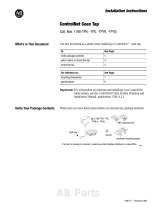 Allen-Bradley ControlNet Coax Tap 1786-TPR Installation Instructions Manual
Allen-Bradley ControlNet Coax Tap 1786-TPR Installation Instructions Manual
-
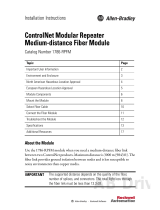 Allen-Bradley ControlNet 1786-RPFM Installation Instructions Manual
Allen-Bradley ControlNet 1786-RPFM Installation Instructions Manual
-
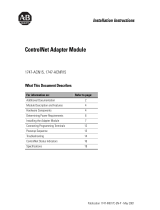 Allen-Bradley ControlNet 1747-ACNR15 Installation Instructions Manual
Allen-Bradley ControlNet 1747-ACNR15 Installation Instructions Manual
-
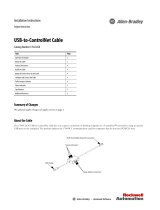 Allen-Bradley 1784-U2CN Installation Instructions Manual
Allen-Bradley 1784-U2CN Installation Instructions Manual
-
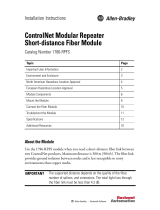 Allen-Bradley ControlNet 1786-RPFS Installation Instructions Manual
Allen-Bradley ControlNet 1786-RPFS Installation Instructions Manual
-
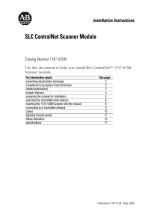 Allen-Bradley ControlNet 1747-SCNR Installation Instructions Manual
Allen-Bradley ControlNet 1747-SCNR Installation Instructions Manual
-
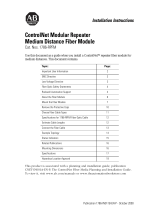 Allen-Bradley ControlNet 1786-RPFM Installation Instructions Manual
Allen-Bradley ControlNet 1786-RPFM Installation Instructions Manual
-
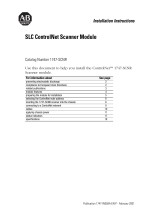 Allen-Bradley ControlNet 1747-SCNR Installation Instructions Manual
Allen-Bradley ControlNet 1747-SCNR Installation Instructions Manual
-
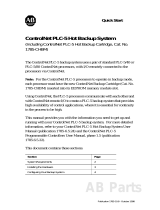 Allen-Bradley ControlNet PLC-5 Guide de démarrage rapide
Allen-Bradley ControlNet PLC-5 Guide de démarrage rapide
-
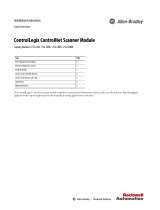 Allen-Bradley ControlLogix ControlNet Scanner Module Installation Instructions Manual
Allen-Bradley ControlLogix ControlNet Scanner Module Installation Instructions Manual




























